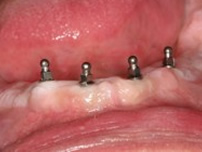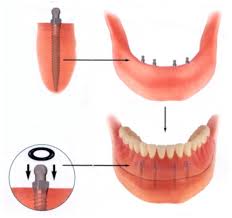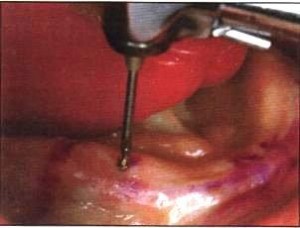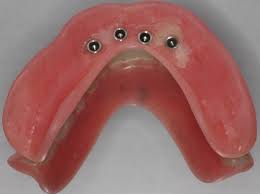What is Mini Dental Implants?
A Mini Dental Implant is a tiny dental implant. They are usually constructed from titanium and have calcium phosphate along the length of the screw portion or it is sprayed with calcium phosphate. They are generally used to help and stabilize dentures. On the top part of the implant is a round retaining fixture that snaps into a corresponding fixture on the denture. The great advantage is that, unlike a usual full implant, no significant surgery, bone-grafting and healing time is required. The mini dental implants can be placed in a single, relatively non-invasive procedure and the prosthesis (denture) can be fitted on the same day. MDI’s help to preserve gum and bone health better than other types of teeth replacements. They can really be a great solution for patients who struggle with unstable dentures which move around when they try to eat or speak.

Mini Dental Implants
Advantages of Mini Dental Implants
- No Invasive surgery required.
- No need for bone grafts
- Fewer complications
- Multiple implants can be placed in one appointment
- Quick recovery after placement
- Can be placed, even when there has been extensive bone-loss
- Less cost than with traditional full-sized implants
- Great way to stabilize dentures
Advantages of Mini Dental Implant supported Dentures
- Firm, stable denture fit. The denture will not slip or wobble anymore.
- Easier chewing and speech
- Quick treatment time with no cutting or sutures
- Great permanent results
- Easy to clean resulting in less problems with food getting trapped under dentures or bad breath.
- No need for messy denture adhesives

Mini Dental Implants to Support a Denture
Disadvantages of Mini Dental Implants
- A competent, well trained dentist should place the MDI’s to prevent complications or failiure.
- Careful assessment and treatment planning required.
- May not be suitable for patients who tend to bruxsate (grind on their teeth).
- Enough vertical bone required. In some patients there may not be enough bone to place the mini dental implants.
Placement of Mini Dental Implants
Comprehensive examination, including radiographs will need to be done first. Force analysis should be done, taking bite pattern into account. The actual implant procedure only takes about an hour. Local anesthetic will be administered first. A small hole will be drilled in the jawbone for each mini dental implant.

Small hole being drilled into the jawbone.
They often place four mini implants, about 5mm apart, depending on where the most suitable bone is. The implants are screwed into place and tightened.

Placing the Mini Dental Implant
The denture will be marked to show where the implants are, and sent to the laboratory who will prepare the denture to fit over the implants.

Attachments on the denture
The denture can then be fitted. Usually patients do not struggle with much pain after placement. It is relatively easy for the patient to remove the denture for cleaning.